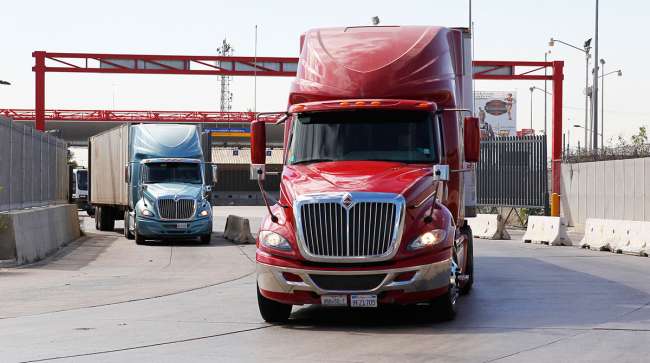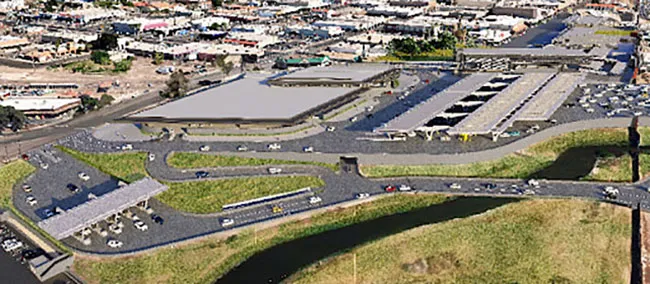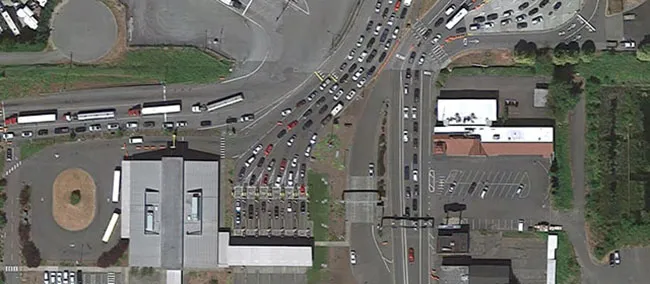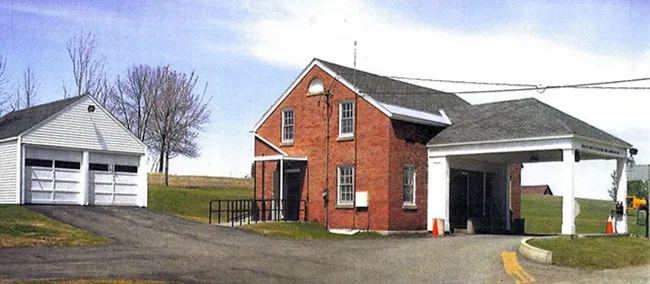Staff Reporter
GSA to Spend $3.4 Billion to Update 26 Land Ports of Entry

[Stay on top of transportation news: Get TTNews in your inbox.]
Replacing pavement at Otay Mesa land port of entry in California is the latest of 50 modernization projects the General Services Administration has embarked on using $3.4 billion in federal infrastructure funds.
GSA selected 26 from 122 land ports of entry under its custody and control as most needing updates due to aging buildings, with many built in the 1930s.
Federal funds are being spent on major modernizations of the 26 sites as well as 21 projects to replace pavement along the borders and three lease purchases at the Mexico border.
Of GSA’s 21 paving projects, 15 are on the Mexican border with the remaining six at the Canadian border.
We’ve awarded a #SmallBusiness #BIL contract for a low-embodied carbon concrete project. It’s for the Otay Mesa #LandPortOfEntry #LowCarbonConcrete #Sustainability https://t.co/xdOKlt2Tzo — GSA (@USGSA) December 9, 2022
A $1.8 million contract was awarded Dec. 7 by GSA for the first use of low-embodied carbon concrete at a land port of entry at San Diego’s Otay Mesa. The new concrete, more able to withstand damage and erosion, will need less maintenance and will replace the current asphalt on a queueing area that is cracked and has potholes from the thousands of daily vehicle crossings.
Scheduled to start next spring, construction will involve closing up to two lanes at a time to remove existing asphalt, fix underground utilities and pour new concrete. At least 11 vehicle inspection lanes will be operable during paving.
“This funding provided GSA with the opportunity to make an important contract award and continue our work improving this binational transportation infrastructure to better support the federal inspection agencies’ mission while lessening the impact on the environment,” said Dan Brown, Pacific Rim regional commissioner of GSA Public Buildings Service.
Other work in California includes increasing vehicle capacity and creating new inspection facilities at the Calexico West land port of entry, the main border linking Imperial Valley agriculture to Mexico.

Calexico port of entry by U.S. General Services Administration
GSA is directing its bipartisan infrastructure law funds across 11 states. Marking the one-year anniversary of the law Nov. 15, GSA Administrator Robin Carnahan noted that modernizing the land ports of entry improves security, lowers consumer costs and strengthens supply chains.
“GSA looks forward to continuing this momentum and delivering projects that will strengthen local economies, facilitate the flow of commerce and trade, and help our partners at the Department of Homeland Security-Customs and Border Protection ensure a safe and secure border,” Carnahan said.
Work has begun in all 26 locations in 11 states: Alaska, Arizona, California, Idaho, Maine, Minnesota, New York, North Dakota, Texas, Vermont and Washington.
Arizona is getting a new dedicated commercial land port in Douglas to better enable crossing of oversize mining equipment and chemicals. The project will include building primary commercial inspection booths, a canopy, head house and administrative building, as well as secondary vehicle inspection docks, a hazmat building and a Federal Motor Carrier Safety Administration facility.
Along with the San Luis I noncommercial port, the Raul H. Castro land port is being renovated. Built in 1933 and expanded in 1993, Raul H. Castro has a current configuration that creates safety hazards for inbound and outbound trucks, which must maneuver within the same undersize commercial vehicle inspection compound, which slows traffic.
“Once commercial activities are transitioned to the new Douglas port, the necessary demolition and reconstruction of this legacy facility will replace the systems and buildings that are undersized and well beyond their useful life,” according to GSA.
Texas has a noncommerical land port, Brownsville Gateway, that will be enlarged along with the El Paso Bridge of the Americas, which processes toll-free inbound and outbound commercial, noncommercial and pedestrian traffic to and from Ciudad Juarez in Mexico. GSA plans to improve traffic flows and trade movements by adding a new administration building, pedestrian processing lanes, a head house, passenger vehicle lanes, a kennel and commercial vehicle inspection area.

Pacific Highway land port of entry at Blaine, Wash. (U.S. General Services Administration)
Three projects slated for Washington’s ports are at Lyden (adding lanes for commercial traffic and improve site security, Sumas (updating building operations and commercial vehicle screening) and Blaine (expanding vehicle inspection lanes). Home to the Pacific Highway land port, Blaine has the largest and busiest U.S.-Canadian port in the West. It is experiencing longer wait times and processing 2 million private and commercial vehicles annually.
Neighboring Idaho’s Porthill port, operating for 55 years, is unable to meet today’s needs for services. It will have extra inspection lanes and modern facilities.
Alaska’s Alcan land port of entry, over 50 years old, operates 24 hours serving private vehicles and commercial truck traffic between Tok and the Yukon Territory in Canada. Located in a remote area with extreme weather, the port will have enclosed primary and secondary inspection areas in a single building to shield Customs and Border Patrol personnel from harsh weather while they work.
North Dakota’s Dunseith land port relies on a main building and canopy constructed in the 1960s. Federal dollars will be used to construct a new main building, commercial inspection sites and outdoor livestock inspection areas.

The Alburg Springs land port of entry is located in a rural area just west of Lake Champlain in Vermonty. (U.S. General Services Administration)
Two land ports in Minnesota are being improved. Grand Portage will have new inspection lanes, canopy and parking areas and an enclosed facility space. International Falls (at the foot of the international bridge across the U.S.-Canadian border from Fort Frances, Ontario) was built in 1993 and is functionally obsolete despite seeing the state’s highest traffic levels of any land port. It will be renovated with larger facilities to add capacity for cross-border trade and travel.
Five Vermont land ports (Alburg Springs, Beebe Plain, Highgate Springs, Norton and Richford) will have facilities expanded and modernized. Among these aging facilities, one was built in 1933, another in 1934 and two in 1937. Vermont’s 13 land ports handle bilateral trade worth over $2.2 billion in goods.
New York’s two land ports designated for federal investments also were built in the 1930s. Trout River will be expanded with two inspection lanes and a 14,400-square-foot building, while Rouses Point will receive new inspection lanes and a rail inspection platform.
With 24 official border crossings, Maine has five land ports built in the 1930s that are scheduled for major renovations, including new main buildings and inspection areas.
Want more news? Listen to today's daily briefing below or go here for more info:

